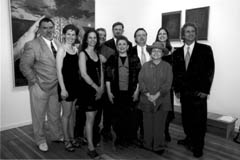|

Deaf
Art Sees Light: Lexington School Celebration
by
M. C. Cohen
“Seeing
Through Deaf Eyes” is a daring and different art exhibit featuring
14 of the best known deaf artists around the country. The exhibit
honored the 135th anniversary of the Lexington School and Center
for the Deaf in Queens, New York.
The participating artists featured a wide variety of styles, including
photography and classical, modern non-expressionist and impressionist
painting. Most (but not all) of the themes were based on being
deaf. This genre of art is called De’VIA—Deaf View/Image Art.
According to the curators of the exhibit Leslie Kushner and Jane
Alpert, “the work of deaf artists explores, among other subjects,
the history and oppression of deaf people, the beauty of artistry
of sign language, and the anger at the stigma of deafness.”
“I’m
fascinated by texture,” said Rita Straubhaar, the exhibit’s top
photographer, who specializes in flowers and nature. “Deaf people
are more interested in light and texture. Feeling of softness
or bumps.”
Chuck Beard, one of the founding artists of the De’VIA art movement,
featured his painting Left and Right, a work that jumped
out at you the moment you entered the room. Depicting the two
sides of the human brain, “the painting symbols—the sun and the
moon, the crossed calla lilies—represent the artist as a person
between the hearing and deaf worlds,” said Beard.
“People
ask me, are you a deaf artist or a painter?” he said. “It’s not
important to label yourself. I believe in art that comes from
the spirit.”
“We
felt that by bringing together 14 prominent deaf artists we would
accomplish a dual purpose,” said Oscar P. Cohen, Superintendent/Director
of the Lexington school: “to display the talent and potential
of deaf people to the general public, and to present role models
for deaf children.”
Lexington is the largest school of its kind in New York State.
“Our goal is to teach the deaf and the hard of hearing communication
and language skills so that they can compete with the general
population,” said Cohen. Deaf schools have always been the center
of strong and lasting ties in the deaf community. Lexington, a
school that was founded in 1865 in New York City, was originally
established to meet the needs of deaf children of immigrants.
However, its focus has since broadened to serve the entire deaf
community.
Charles Wildbank, another artist in the exhibit, takes photographs
and makes oil paintings out of them. He uses predominantly deaf
themes. He used to be a teacher for the deaf but left to pursue
his art, but still considers himself an educator. “You need to
be an inspiration to others,” he said. “The only way is to love
what you do. I love to paint. I want to help the deaf. I’m still
a teacher but I don’t have to be paid to do it.” #
Education Update, Inc., P.O. Box 20005, New York, NY 10001. Tel:
(212) 481-5519. Fax: (212) 481-3919. Email: ednews1@aol.com.
All material is copyrighted and may not be printed without express consent of
the publisher. © 2001.
|

